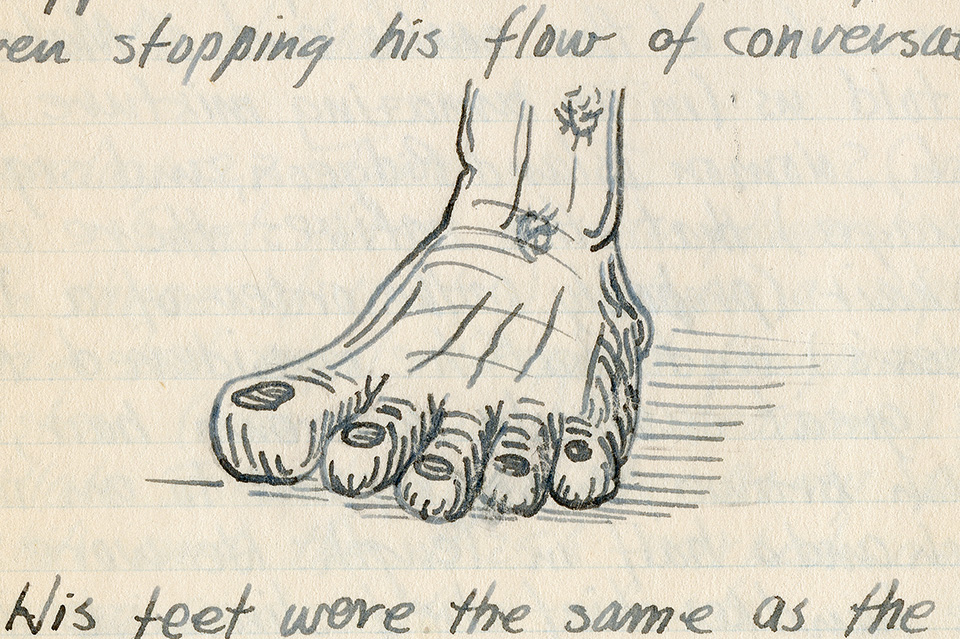“Cactus,” Carney Field, Guadalcanal
Sent three of our planes (along with three of 102’s) out on the night strike last night. Dropped fragmentation clusters (murderous little beauties on Ballale Island strip. The army pasted Kahili and the B-25s worked over the shipping and smaller islands.
This being Sunday, some of the natives who work near here came over to trade with us. Most were rather timid, but one “John” from Malaita was outstanding in his intelligence and vociferousness. Stack Glanz asked him first, “Call’um name belong you?” and he smiled and answered “John.” Glanz asked him, “How fella Mary belong you?” “You mean wives?” (Just to show as he knew his English.) He said he wasn’t married, but he came from one of the coastal villages on NE Malaita. It was a two day trip home by way of Tulagi. We showed him a chart of the islands that he picked out Malaita.
He pointed to Maramasike on the south end of Malaita and told us (in an amazing mixture of English, Samoan island pidgin, and sign language) that the natives there were long hair (probably on the order of the Fiji Islanders) that he considered that as a great curiosity. His own hair, a reddish-brown, was cropped to an inch or inch and a half in length.
He wore a white handkerchief tied slingways from right shoulder to left armpit. Around his middle was a length of green felt-like material (billiard table cloth?) secured by a wide leather belt, for which hold on various little bags and tobacco pouches. His skin was very black, his teeth were stained with what must’ve been betel nut. The most amazing thing was the size of his feet. They spread from a fairly normal ankle and heel to width of 7 to 8 inches at the toes. Their thickness was double that of an average foot.
 He brought down the house when he finished his cigarette, dropped it on the floor and stepped on it with his bare foot without even stopping the flow of conversation. His feet were the same as as the rest of the natives, so it must be the result of generations of bare feet. With him he had several grass skirts which he traded very cagily for exactly the type of knife he wanted – a hunting knife with an eight-inch blade. He politely refused all attempts to trade him a pocketknife or a machete. He indicated that “pocketknife” was used to comb their hair with. He traded his skirts for two of the desired knives, explaining that one knife was for the chief of his village at Malaita (Probably insurance against having to give his own to the chief.) He then gave us a demonstration of the differences between English and American styles of boxing. This was followed by examples of what he’d do to a Jap with his knife – all very scientific and not at all boastful. The natives seem to hate the Japs and when we referred to them he said that most of the Japs were on “Bougainvillee.” We told him we been up there the night before bombing and he broke into a broad grin, exclaiming “Good! Good!” followed by airplane motions, whistle of a falling bomb, and the resulting explosion to show us he understood thoroughly.
He brought down the house when he finished his cigarette, dropped it on the floor and stepped on it with his bare foot without even stopping the flow of conversation. His feet were the same as as the rest of the natives, so it must be the result of generations of bare feet. With him he had several grass skirts which he traded very cagily for exactly the type of knife he wanted – a hunting knife with an eight-inch blade. He politely refused all attempts to trade him a pocketknife or a machete. He indicated that “pocketknife” was used to comb their hair with. He traded his skirts for two of the desired knives, explaining that one knife was for the chief of his village at Malaita (Probably insurance against having to give his own to the chief.) He then gave us a demonstration of the differences between English and American styles of boxing. This was followed by examples of what he’d do to a Jap with his knife – all very scientific and not at all boastful. The natives seem to hate the Japs and when we referred to them he said that most of the Japs were on “Bougainvillee.” We told him we been up there the night before bombing and he broke into a broad grin, exclaiming “Good! Good!” followed by airplane motions, whistle of a falling bomb, and the resulting explosion to show us he understood thoroughly.